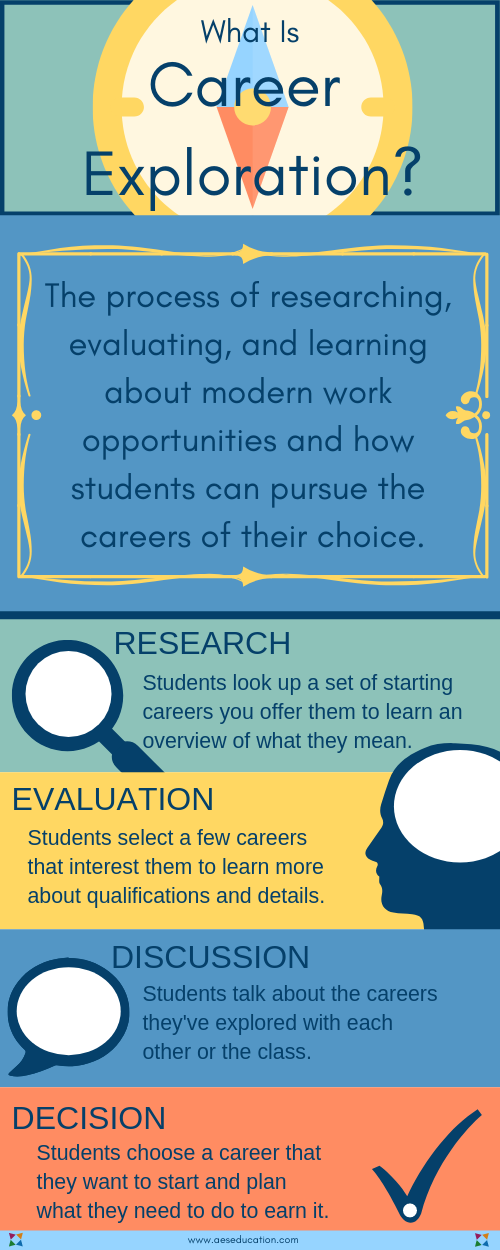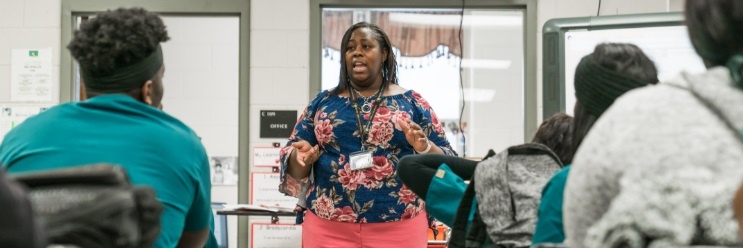Career Exploration | Career Readiness
What Is Career Exploration & How Do You Teach It?
As a career exploration curriculum developer, we hear from thousands of teachers every year interested in teaching career readiness.
During those conversations, teachers ask six common questions about career exploration:
- What is career exploration?
- How does career exploration work?
- Why is career exploration helpful?
- How often should students participate in career exploration?
- How do you know when career exploration education succeeds?
- How do you teach career exploration?
In this article, we'll dive into the answers to each of these questions to help you better understand what career exploration is and how to teach it.
You'll also have the opportunity to download a free career exploration lesson and activity to implement in your classroom today!
1. What Is Career Exploration?
In education, career exploration is the process of researching, evaluating, and learning about modern work opportunities and how students can pursue the careers of their choice.
That makes career exploration one of the most important subjects in terms of long-term life planning for students in any grade.

With that in mind, it’s time to talk about career exploration in detail, starting with how career exploration works.
2. How Does Career Exploration Work?

Different schools, education experts, and teachers all have a different way of teaching career exploration.
For the most part, they break down the four main steps that help students learn more about the working world around them.
- Research
- Evaluation
- Discussion
- Decision
Before jumping right into these steps, it’s smart to start with a seed list of careers that are either common or popular in the world right now.
Careers like software developer, serial entrepreneur, social media strategist, and others are all great places to start for modern careers.
You can also use any number of more established or “traditional” careers, like accountant, psychiatrist, construction worker, clerk, and more.
Plus, you can always consider local or regional jobs that are on the rise. In many areas, that includes healthcare careers like certified nursing assistants, phlebotomists, or another area of expertise.
Now that you have your seed list of careers, you can dive into the steps of career exploration!
Each of these steps includes its own processes and procedures. We’ll take a look at each one in sequence so you can plan the best career exploration class possible!
To start, let’s talk about research.
Career Exploration Step 1: Research

The research step of career exploration introduces students to specific careers that they want to understand more.
This is where students take your seed list, choose a few careers that sound interesting, and learn more about them.
You have a ton of different ways to do this.
The most popular way is to have students go online to school-sanctioned websites to learn more. Your school may even pay for career exploration software that’s specifically designed for students to learn more about the working world.
Another way is to lecture. This relies on your knowledge of careers and traditional classroom resources (like textbooks).
A third way is to network with professionals in your area and have them come discuss their career with your class.
This teaching method requires clearance from your school and some degree of coordination with individuals outside your school, which can get to be a lot of work on top of your regular teaching responsibilities.
But if students seem drawn to one career in particular, you have a perfect opportunity to contact someone who actually works in that field to speak to your class.
Regardless of how you teach the research phase of career exploration, you’ll have a perfect segue into the next step — evaluation.
Career Exploration Step 2: Evaluation

The evaluation step of career exploration empowers students to analyze the research they’ve conducted so they can get a deeper understanding of their favorite jobs.
Part of that understanding may be learning that a career simply isn’t a good fit for them at the moment.
That doesn’t mean that students will completely disregard a career, especially if they’re elementary- or middle-school aged students.
But it does mean that they can start looking into similar careers that may be more interesting to them.
The process tends to follow a similar pattern for any grade level in career exploration.
First, the students look at the career(s) that they chose to evaluate.
Then, they also look at the careers that support (or are supported by) their first career.
That lets students branch off from their initial career interest and learn more about a collection of careers instead of just one at a time.
This is especially useful for tech-oriented careers like a software developer. Yes, software developers are highly in-demand right now, but to succeed, they need to work with information technology professionals, business professionals, quality assurance, marketing teams, and more.
In other words, a student may start the evaluation process by looking at a career that they think is perfect.
By the time they’re done reading, they may have a different career aspiration, purely because they learned something new!
The important victory here is that you’ve expanded your students’ horizons so that they can understand the breadth of possibilities in their futures.
Once students have done that, they can share their findings with the class during the discussion phase.
Career Exploration Step 3: Discussion

The discussion step of career exploration encourages students to talk about what they learned with their peers.
This lets students compare the careers they chose, why they liked those careers, and other offshoot careers that they discovered.
Students may also learn about new job tracks from their peers. The student from our previous example could tell their friends about IT and how interesting it is.
Likewise, two students may find out that they have a mutual career interest and hit it off talking about the requirements and possibilities of the job.
Students may also disagree about which careers they like. This may sound like a problem on the surface, but it can actually lead to constructive and educational conversation.
You may have to mediate the conversation a little bit, but ideally, each student discusses what they liked about one career and didn’t like about another.
This helps students understand what interests can lead to other careers while providing them with a fresh perspective on careers in general.
With that in mind, students can now get to the fourth step of almost any career exploration curriculum.
Career Exploration Step 4: Decision

The decision step of career exploration revolves around students deciding which career they’d like to pursue more.
This does not mean that a student is choosing the career they’ll be for their entire lives.
But — just like the first three steps of the career exploration process — it gives students a direction so they can follow their passion to a fulfilling career.
This phase is typically the fastest of the career exploration steps. You can set whatever requirements you’d like to help students move forward in their career curiosities. You could also leave it all up to them how they go after their dreams.
Regardless, these four steps are the basics of career exploration.
So why go through all of this, anyway?
After all, if your students are only with you for a semester or a quarter, can they really learn everything they need to improve their career outlooks?
The answer is yes!
3. Why Is Career Exploration Helpful?

First and most obviously, career exploration helps students discover the jobs that are available to them after they’ve graduated from school.
In addition, they also learn what level of education, work experience, and professionalism they need to succeed in their chosen career.
For example, someone who wants to go into marketing — a career available to individuals with or without a college education — requires significantly different requirements than someone who wants to pursue the decade of post-secondary education required to be a medical doctor.
Students also learn about the income they can expect from a career, how they can obtain that income, and how they can advance throughout the tiers of their career’s expertise.
In other words, students get a head start on their post-school lives by learning about the real world.
When you have someone from that career speak to the class about their experience, you increase that value exponentially as well.
After all, career exploration classes are responsible for creating internship, externship, co-op, and apprenticeship opportunities for students.
That’s the final reason why career exploration is so helpful. With the right support and direction, students can actually start on their careers today.
They don’t have to wait to graduate.
They don’t have to wait until they have a full resume of experience.
They can get a head start on the job market when they’re 14, if they’d like.
But 14-year-olds aren’t the only students benefiting from career exploration.
In fact, some school districts may mandate that students take career exploration classes multiple times in their academic careers
4. How Often Should Students Participate in Career Exploration?

With the ever-increasing pace of technology, the American job market can change overnight.
That’s why it’s so crucial to take a look at career exploration opportunities for students throughout their academic careers — not just in one grade!
Major cities are especially sensitive to changes in economics or job distribution since so many professionals live within their borders.
Rural areas may be more insulated, especially in towns with more self-sufficient economies.
Either way, careers change!
They may change in terms of scope, requirements, tools, salaries, and — most importantly — availability, among other factors.
The best way to make sure students are ready for those changes is to keep them up to date! That way, they can successfully learn all of the new information that plays a role in the jobs of their dreams.
Still, this leads us to our last question about laying out your career exploration curriculum.
How can you tell when your career exploration class is successful?
5. How Do You Know When Career Exploration Succeeds?

“Success” is a tricky topic when it comes to teaching.
Everyone wants to know whether they’re successfully teaching — but how do you actually measure that success?
For career exploration, you have a couple different methods at your fingertips.
First, you can measure the percentage of students in your class who have concretely chosen a career they want to investigate further.
In other words, you keep track of how many students have a definite answer in the decide portion of career exploration.
For the students who don’t have a definitive answer, you know that you have to follow up with them to get them engaged with the subject or a career that’s more suited to their interests.
Another way to measure success is with a summative assessment given as a traditional test or essay.
This lets your students answer questions about the class based on what they learned — not necessarily a right or wrong answer.
Instead, you get students to talk about what they learned in a class, why they liked something, why they disliked something, and what they want to do next.
The students who really get into your career exploration class will get into this assessment in no time! All they have to do is talk about what they liked and why they liked it, which is a fun and expressive activity for students of any age.
The students who aren’t quite feeling the career exploration class may have more difficulty. Again, this shows you that they didn’t quite engage with the curriculum as you might’ve wanted, which gives you the opportunity to circle back and engage these students in other ways.
With these two options, you’re all prepped and ready to run a career exploration class with a clear indicator of success!
So with everything said and done, let’s talk about one big question we haven’t answered yet.
How do you actually teach career exploration?
6. How Do You Teach Career Exploration?
When it comes to teaching a career exploration curriculum, there are hundreds of options available.
Mainly, you'll find career exploration lessons and activities for middle school, which is the most common age group where career exploration is taught.
Most of the resources you can find online can be a great supplement to fill out an existing career readiness curriculum.
However, if you’re in need of a full curriculum to teach career exploration among other concepts and skills, consider checking out iCEV's comprehensive career exploration curriculum.
iCEV's curriculum contains hundreds of hours of content to help you teach dozens of career readiness skills through hands-on activities, engaging digital lessons, and more.
It’s a great option for anyone who is just getting started as a career readiness teacher and needs materials to fill their entire course.
To see if the curriculum is the right fit for your classes, download a free introduction activity and try it out for yourself.
This career exploration activity helps your students identify possible career choices and think about the steps needed to obtain those careers.
Click below to download your free activity to start teaching career exploration now!


